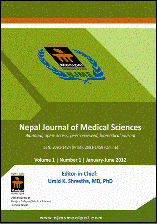Foreign Body in the Esophagus-Comparison Between Adult and Pediatric Population
DOI:
https://doi.org/10.3126/njms.v1i1.5797Keywords:
Foreign body, esophagus, rigid bronchoscopyAbstract
Background: Foreign body (FB) impaction in the esophagus is a common emergency in all age groups. In the children coins are the commonest foreign bodies while bones have been found as the commonest in adults.
Methods: This is a retrospective study comparing FB in the esophagus in adult and pediatric population between June 2007 and May 2010 in Manipal Teaching Hospital, Pokhara, Nepal. Most of the patients underwent rigid esophagoscopy and FB removal; few were removed under anesthesia by the anesthesiologists. Comparison was done in terms of pattern of FB, their site of impaction and relative ease of removal. Data were collected from the case file available from the medical record department and analysed using SPSS 11.6.
Results: A total of 63 cases were included in this study. Out of which 28 (44.4%) patients were children and 35 (55.5%) were adults. Coin was the most common foreign body in the pediatric population (82.1%) whereas bones were the commonest ones (91.4%) in adults. In the pediatric population the commonest site of impaction was upper esophagus (92.8%) whereas mid esophagus was the commonest site (65.7%) in adults.
Conclusion:There are differences in various aspects of impacted foreign bodies in esophagus in adult and pediatric populations. Coins being the commonest foreign bodies in children are relatively easier to remove due to their higher location and less chances of trauma. Contrary in the adults, bones being the commonest foreign body are difficult to remove due to the lower location and chances of trauma.
Keywords: Foreign body; esophagus; rigid bronchoscopy
DOI: http://dx.doi.org/10.3126/njms.v1i1.5797
Nepal Journal of Medical Sciences. 2012; 1(1): 42-44
Downloads
Downloads
How to Cite
Issue
Section
License
Copyright © by Nepal Journal of Medical Sciences. The ideas and opinions expressed by authors of articles summarized, quoted, or published in full text in this Journal represents only opinions of authors and do not necessarily reflect the official policy of Nepal Journal of Medical Sciences or the institute with which the author(s) is (are) affiliated, unless so specified.




